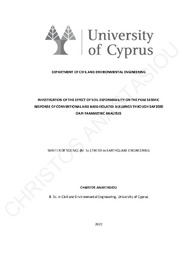| dc.contributor.advisor | Komodromos, Petros | en |
| dc.contributor.author | Anastasiou, Christos | en |
| dc.coverage.spatial | Cyprus | en |
| dc.creator | Anastasiou, Christos | en |
| dc.date.accessioned | 2022-06-01T05:57:00Z | |
| dc.date.available | 2022-06-01T05:57:00Z | |
| dc.date.issued | 2022 | |
| dc.identifier.uri | http://gnosis.library.ucy.ac.cy/handle/7/65249 | en |
| dc.description.abstract | The earthquake resistant design of a structure is implemented according to the relevant provisions of the seismic codes of each country. Most seismic codes, including the Eurocodes, assume that the structure is fixed-supported to a rigid ground. This ‘’conservative’’ simplification is based on the assumption that potential contribution of soil deformability in the seismic response of a structure is considered as beneficial, compared to the response of the corresponding fixed-supported. Therefore, the influence of soil deformability is ignored, assuming that it can be only beneficial. However, in some cases, it has been observed that the peak seismic response of a structure founded on a rigid ground, without the effect of soil deformability, may lead to a lower estimation of the actual peak seismic response. In addition, taking into account the soil deformability, the structure’s fundamental eigenperiod may increase. Consequently, significant differences in the seismic response of structures, may emerge due to the soil deformability, which should not be always neglected. In this thesis, the behaviour of a spatial conventionally supported reinforced concrete building, as well as the corresponding base-isolated structure, are examined, taking into account the soil deformability. For the conventionally supported structure, linear time-history analysis is conducted, while non-linear time-history analysis is performed for the base-isolated structure, in order to take into account, the nonlinear behavior of the seismic isolation system. The soil deformability can be simulated using six springs. Specifically, one translational spring in each horizontal direction X and Y, one in the vertical Z direction, and one rotational spring in each direction (X, Y and Z). The stiffnesses of the springs are calculated in accordance with the foundation characteristics and the mechanical properties of the supporting soil. In order to examine the influence of the soil deformability in the peak seismic response, the buildings are assumed to be founded on three different soil types: rock (which represents the fixed support to a rigid ground), sand and soft clay. Moreover, both the conventionally fixed-supported building and the base-isolated building are subjected to both near-fault (NF) and far-fault (FF) seismic excitations, in order to investigate the effect of the earthquake characteristics, in addition to the soil deformability, on their peak seismic responses. Furthermore, in this thesis the entire procedure of configuration and parametric analysis of the structural models are conducted through the SAP2000 software, using the SAP2000 Open Application Programming Interface (OAPI) in combination with the Python language. Basically, the OAPI is the interface tool that allows access to SAP2000 to perform parametric analyses, using a programming language, such as Python. More specifically, the data and parameters that are required to perform dynamic analyses and parametric studies are written in the Python programming language and then transferred to SAP2000, by its OAPI. It is remarkable that the operation of SAP2000 is done entirely in the background, through the OAPI, without any need for intervention by the user. Consequently, parametric analyses can be easily conducted with great flexibility and efficiency. | en |
| dc.language.iso | eng | en |
| dc.publisher | Πανεπιστήμιο Κύπρου, Πολυτεχνική Σχολή / University of Cyprus, Faculty of Engineering | |
| dc.rights | Attribution-NonCommercial-NoDerivs 3.0 Greece | * |
| dc.rights | info:eu-repo/semantics/openAccess | en |
| dc.rights | Open Access | en |
| dc.rights.uri | http://creativecommons.org/licenses/by-nc-nd/3.0/gr/ | * |
| dc.title | Investigation of the effect of soil deformability on the peak seismic response of conventional and base-isolated buildings through SAP2000 OAPI parametric analyses | en |
| dc.type | info:eu-repo/semantics/masterThesis | en |
| dc.contributor.committeemember | Loukidis, Dimitrios | en |
| dc.contributor.committeemember | Charmpis, Dimos | en |
| dc.contributor.department | Τμήμα Πολιτικών Μηχανικών και Μηχανικών Περιβάλλοντος / Department of Civil and Environmental Engineering | |
| dc.subject.uncontrolledterm | SOIL DEFORMABILITY | en |
| dc.subject.uncontrolledterm | PARAMETRIC ANALYSES | en |
| dc.subject.uncontrolledterm | SAP2000 OAPI | en |
| dc.subject.uncontrolledterm | BASE-ISOLATED BUILDINGS | en |
| dc.author.faculty | Πολυτεχνική Σχολή / Faculty of Engineering | |
| dc.author.department | Τμήμα Πολιτικών Μηχανικών και Μηχανικών Περιβάλλοντος / Department of Civil and Environmental Engineering | |
| dc.type.uhtype | Master Thesis | en |
| dc.contributor.orcid | Komodromos, Petros [0000-0001-6803-5013] | |
| dc.gnosis.orcid | 0000-0001-6803-5013 | |


